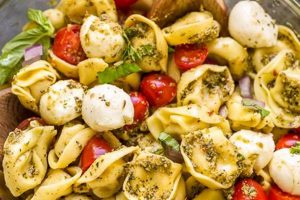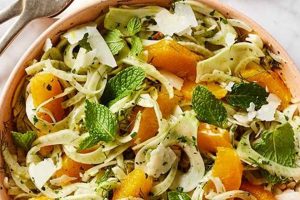Cooked salmon, flaked and combined with various ingredients, forms the foundation of a versatile dish. Mayonnaise is a common binder, often accompanied by celery, onion, and seasonings such as dill, lemon juice, and black pepper. Variations incorporate ingredients like capers, hard-boiled eggs, fresh herbs, or different types of mustard. This mixture can be enjoyed as a sandwich filling, a salad topping, or served with crackers.
The dish offers a nutritious and flavorful meal option. Salmon provides a rich source of protein and omega-3 fatty acids, contributing to heart health and overall well-being. Its adaptability allows for customization to individual preferences and dietary needs, making it suitable for a range of occasions from casual lunches to more formal gatherings. The historical use of preserved fish in salads provides context for its enduring popularity, showcasing its evolution from a practical food source to a culinary staple.
This exploration will delve further into the specifics of preparing this dish, covering diverse approaches, ingredient selection, and helpful tips for achieving optimal flavor and texture.
Tips for Salmon Salad Preparation
Achieving optimal flavor and texture in salmon salad relies on careful attention to detail throughout the preparation process. The following tips offer guidance for creating a superior culinary experience.
Tip 1: Proper Salmon Selection and Cooking: Starting with high-quality, fresh, or properly frozen salmon is crucial. Whether grilling, baking, or poaching, ensure the salmon is cooked thoroughly but remains moist. Overcooked salmon results in a dry, less desirable salad.
Tip 2: Thorough Bone Removal: Meticulously remove all bones and skin before flaking the salmon. Small pin bones can be easily overlooked, so careful inspection is essential for a pleasant dining experience.
Tip 3: Gentle Flaking Technique: Avoid over-processing the salmon during flaking. Large, distinct flakes contribute to a more appealing texture than finely shredded or mashed fish.
Tip 4: Balanced Flavor Profiles: The interplay of ingredients significantly impacts the final result. Balance the richness of the salmon with the acidity of lemon juice or vinegar, and complement the flavors with fresh herbs like dill or chives.
Tip 5: Mayonnaise and Binder Selection: While mayonnaise is traditional, Greek yogurt or a combination of the two offer lighter alternatives. Consider the flavor profile of the other ingredients when selecting the binder.
Tip 6: Ingredient Incorporation: Gently fold in the chosen ingredients to ensure even distribution without crushing the delicate salmon flakes. Overmixing can lead to a less desirable texture.
Tip 7: Chilling and Serving: Chilling the prepared salad allows the flavors to meld and enhances the overall experience. Serve the salad chilled on bread, crackers, lettuce cups, or as a standalone dish.
By following these tips, one can elevate salmon salad from a simple dish to a culinary delight. Attention to detail in each step contributes to a flavorful and texturally pleasing result.
These practical insights provide a strong foundation for crafting exceptional salmon salad. The following section will conclude with suggestions for variations and serving options.
1. Fresh, High-Quality Salmon
Fresh, high-quality salmon forms the cornerstone of exceptional salmon salad. The inherent flavor and texture of the fish directly influence the final dish. Salmon exhibiting vibrant color, firm texture, and a fresh, mild aroma indicates superior quality. These characteristics translate to a more palatable and enjoyable salad. Conversely, using lower-quality salmon, characterized by dull color, mushy texture, or a strong fishy odor, can compromise the overall sensory experience. The delicate flavor of fresh, high-quality salmon allows the other ingredients to complement rather than mask its taste.
Consider the example of a salmon salad made with wild-caught Alaskan sockeye. Its rich, vibrant flavor profile shines through, requiring minimal seasoning. Compare this to a salad made with previously frozen, farm-raised salmon, which might possess a milder taste and softer texture, necessitating more assertive seasonings to compensate. The quality of the salmon significantly impacts the balance of flavors within the salad.
Understanding the importance of fresh, high-quality salmon provides a foundation for crafting superior salmon salad. This knowledge empowers consumers to make informed purchasing decisions. Selecting premium salmon not only enhances the flavor and texture of the dish but also ensures a more nutritious and satisfying meal. Prioritizing quality ingredients ultimately leads to a more rewarding culinary experience.
2. Proper Cooking Methods
Proper cooking methods are essential for achieving optimal texture and flavor in salmon salad. Overcooked salmon becomes dry and crumbly, resulting in a less desirable salad texture. Conversely, undercooked salmon presents food safety risks. The ideal cooking method yields moist, flaky salmon that readily separates into large pieces, perfect for incorporating into the salad. Different cooking methods impart unique characteristics to the salmon, influencing the final dish’s flavor profile. Poaching produces a delicately flavored, moist salmon, while grilling imparts a smoky char. Baking offers a balance of moisture retention and flavor development.
Consider the impact of poaching versus grilling on the final salad. Poached salmon, with its delicate flavor, allows the other ingredients, such as fresh herbs and lemon juice, to shine. A grilled salmon salad, however, benefits from bolder flavors that complement the smoky char, perhaps incorporating ingredients like roasted red peppers or a chipotle-lime dressing. The chosen cooking method should align with the desired flavor profile of the finished salad. Practical application of this understanding allows for greater control over the final dish, ensuring a balanced and flavorful result.
Mastering proper salmon cooking techniques provides a crucial foundation for creating exceptional salmon salad. The choice of cooking method directly influences the texture and flavor of the salmon, which in turn shapes the overall quality of the salad. Recognizing this connection allows for informed decision-making, enabling culinary control and ensuring a consistently delicious and satisfying final product. This knowledge empowers one to tailor the cooking method to specific recipe variations, further enhancing the culinary experience.
3. Flavorful Complementary Ingredients
Flavorful complementary ingredients elevate salmon salad beyond its basic components, transforming it into a dynamic and nuanced dish. Careful selection and balance of these ingredients enhance the salmon’s inherent richness while adding depth and complexity. Understanding the interplay of flavors allows for a more deliberate and satisfying culinary experience.
- Aromatics:
Aromatics like finely diced red onion, shallots, or chives contribute a pungent sharpness that cuts through the richness of the salmon. These ingredients add a refreshing element and prevent the salad from becoming overly heavy. For example, the subtle bite of red onion provides a pleasant contrast to the creamy texture of the mayonnaise and the fattiness of the salmon.
- Fresh Herbs:
Fresh herbs provide a bright, herbaceous counterpoint to the salmon. Dill, parsley, and chives are classic choices, offering distinct yet complementary flavors. Dill, with its slightly anise-like flavor, pairs particularly well with salmon. Parsley contributes a clean, fresh taste, while chives offer a subtle onion flavor. The choice of herbs can significantly influence the overall flavor profile of the salad.
- Textural Elements:
Ingredients like chopped celery, water chestnuts, or capers introduce textural variety. Celery adds a satisfying crunch, while water chestnuts offer a delicate crispness. Capers contribute a salty, briny burst and a slight firmness. These textural elements prevent the salad from becoming monotonous and enhance the overall sensory experience.
- Acidic Components:
Acidic components, such as lemon juice, vinegar, or pickles, brighten the flavors of the salad and balance the richness of the salmon and mayonnaise. A squeeze of fresh lemon juice provides a vibrant citrus note, while a touch of apple cider vinegar adds a subtle tang. Finely chopped dill pickles contribute both acidity and a pleasant crunch. These acidic elements are crucial for achieving a well-rounded and balanced flavor profile.
The interplay of these complementary ingredients significantly impacts the final character of the salmon salad. Thoughtful consideration of flavor profiles, textures, and acidity levels allows for a customized and harmonious blend. By understanding the role of each ingredient, one can create a salmon salad that is not only delicious but also reflects individual preferences and culinary creativity. A well-composed salmon salad demonstrates a nuanced understanding of flavor balance and elevates the dish from simple fare to a culinary expression.
4. Balanced Seasonings and Binders
Balanced seasonings and binders are fundamental to a successful salmon salad recipe. They provide the crucial link between the primary ingredient, cooked salmon, and the complementary ingredients, transforming individual components into a cohesive and flavorful dish. The careful interplay of seasonings and binders dictates the overall texture, moisture level, and taste experience.
- Binders: Creating Cohesion and Texture
Binders provide the necessary cohesion, holding the flaked salmon and other ingredients together. Mayonnaise is a classic choice, offering a creamy texture and rich flavor. However, alternatives like Greek yogurt, sour cream, or even avocado provide lighter options with distinct flavor profiles. The quantity of binder directly impacts the salad’s consistency, ranging from a chunky, textured salad to a smoother, spreadable mixture. For example, a salmon salad intended for sandwiches might benefit from a higher binder-to-salmon ratio for easier spreading, while a salad served as a main course might prioritize a chunkier texture with less binder.
- Seasonings: Enhancing and Balancing Flavors
Seasonings enhance the natural flavors of the salmon and other ingredients, creating a balanced and nuanced flavor profile. Classic seasonings include salt, black pepper, dill, lemon juice, and paprika. These seasonings can be used individually or in combination to achieve specific flavor profiles. For instance, a Mediterranean-inspired salmon salad might incorporate oregano, garlic powder, and a touch of red pepper flakes, while a more traditional approach might focus on dill, lemon zest, and black pepper. The judicious use of seasonings prevents the salad from becoming bland or overly seasoned, ensuring a harmonious blend of flavors.
- Balancing Act: Achieving Harmony
The key to a successful salmon salad lies in the delicate balance between seasonings and binders. Too much binder can result in a heavy, overly rich salad, while too little can leave it dry and crumbly. Similarly, an excess of seasoning can overpower the delicate flavor of the salmon, while insufficient seasoning results in a bland and uninspiring dish. Achieving the right balance requires careful consideration of the chosen ingredients and personal preferences. A test batch allows for adjustments before serving, ensuring a perfectly balanced and flavorful final product.
- Impact on Overall Experience
The interplay of seasonings and binders directly influences the overall sensory experience of the salmon salad. The texture, moisture level, and flavor profile all contribute to the final perception of the dish. A well-balanced salmon salad offers a pleasant textural contrast between the flaky salmon and the creamy binder, a harmonious blend of complementary flavors, and a satisfyingly moist and cohesive consistency. This attention to detail elevates the salmon salad from a simple dish to a truly enjoyable culinary creation.
The careful consideration of seasonings and binders is paramount in crafting a truly exceptional salmon salad. These elements, when balanced correctly, transform individual ingredients into a cohesive, flavorful, and texturally pleasing dish. The understanding and application of these principles allow for culinary creativity and customization, resulting in a salmon salad that is both satisfying and memorable.
5. Creative Serving Presentations
Creative serving presentations elevate salmon salad from a simple meal to a visually appealing and engaging culinary experience. Presentation impacts perceived value and enjoyment, transforming a basic recipe into a memorable dish. Consideration of various serving styles expands the versatility of salmon salad, adapting it to diverse occasions and personal preferences. The following facets explore the connection between creative presentation and the overall enjoyment of salmon salad.
- Classic Bread and Crackers
Serving salmon salad on bread or crackers offers a familiar and convenient approach. Crustless white bread, croissants, or whole-wheat options provide varied textures and flavors. Crackers, ranging from buttery Ritz to seeded multigrain varieties, offer contrasting crispness. Presentation can be enhanced by carefully arranging the salad on the chosen base, perhaps garnishing with fresh dill or a lemon wedge. This classic approach emphasizes simplicity and ease of preparation.
- Lettuce Wraps and Cucumber Boats
Utilizing lettuce wraps or hollowed cucumber boats provides a lighter, refreshing alternative. Large lettuce leaves, such as butter lettuce or romaine, create convenient cups for holding the salad. Cucumber halves, scooped clean, offer a visually appealing and hydrating vessel. These options cater to health-conscious individuals and add an element of freshness. Garnishing with microgreens or a sprinkle of paprika enhances visual appeal.
- Elevated Platters and Appetizers
For more formal occasions, salmon salad can be presented as an elegant appetizer or part of a larger platter. Small toasts points, endive spears, or avocado halves provide elegant bases for individual portions. Arranging the salad on a platter alongside other complementary items like smoked salmon, cheeses, and olives creates a visually stunning centerpiece. Attention to detail, such as piping the salad onto the serving vessels or incorporating edible flowers, enhances the perceived sophistication.
- Stuffed Tomatoes and Avocados
Hollowed-out tomatoes or avocado halves offer visually striking and flavorful vessels for salmon salad. Ripe tomatoes provide a juicy contrast to the creamy salad, while avocados contribute a complementary richness. These options offer a unique presentation that is both visually appealing and nutritionally balanced. A sprinkle of chopped chives or a drizzle of balsamic glaze adds a finishing touch.
Creative serving presentations transform salmon salad into a versatile dish suitable for various occasions. Whether a casual lunch or a more formal gathering, thoughtful presentation elevates the dining experience. The choice of serving style not only impacts visual appeal but also influences flavor perception and overall enjoyment. By exploring different presentation options, one can discover new and exciting ways to appreciate the classic flavors of salmon salad.
Frequently Asked Questions
This section addresses common inquiries regarding the preparation and enjoyment of salmon salad.
Question 1: What is the best type of salmon to use for salmon salad?
Wild-caught salmon, such as sockeye or king, generally offers a richer flavor and firmer texture, contributing to a superior salad. However, farm-raised salmon can also produce satisfactory results. Canned salmon provides a convenient alternative, though its texture differs from fresh or frozen options. Ultimately, the choice depends on individual preferences and budget.
Question 2: How can one ensure food safety when preparing salmon salad?
Thorough cooking of the salmon to an internal temperature of 145F (63C) eliminates potential bacterial risks. Prompt refrigeration of both cooked salmon and the prepared salad further mitigates food safety concerns. Maintaining a clean preparation area and avoiding cross-contamination between raw and cooked ingredients are also crucial.
Question 3: How long can salmon salad be stored?
Properly stored in an airtight container in the refrigerator, salmon salad typically remains safe to consume for three to four days. Visual and olfactory inspection should always precede consumption. Discarding the salad at the first sign of spoilage is essential for food safety.
Question 4: Can salmon salad be frozen?
While freezing salmon salad is possible, it’s generally not recommended. Freezing can negatively impact the texture of the mayonnaise or other binders, resulting in a less desirable consistency upon thawing. The delicate texture of the salmon itself can also be compromised by freezing.
Question 5: What are some healthy variations of traditional salmon salad recipes?
Substituting Greek yogurt for mayonnaise, either partially or entirely, reduces fat content while adding a tangy flavor. Incorporating a variety of fresh vegetables, such as chopped celery, bell peppers, or cucumbers, increases nutritional value and adds textural complexity. Using whole-grain bread or crackers for serving further enhances the nutritional profile.
Question 6: How can one prevent salmon salad from becoming too dry?
Avoiding overcooking the salmon is crucial for preventing dryness. Adding sufficient binder, such as mayonnaise or Greek yogurt, helps retain moisture. Incorporating finely diced celery or cucumber also contributes moisture and textural complexity. Adjusting the binder-to-salmon ratio achieves the desired consistency.
Addressing these common questions provides clarity on key aspects of salmon salad preparation and consumption. Understanding these points empowers individuals to create and enjoy this versatile dish safely and confidently.
This concludes the frequently asked questions section.
Conclusion
Exploration of salmon salad recipes reveals the interplay of key elements contributing to a successful dish. Fresh, high-quality salmon, cooked to perfection, forms the foundation. Complementary ingredients, carefully selected and balanced, enhance the salmon’s inherent flavor and texture. Binders and seasonings play a crucial role in creating cohesion and depth of flavor. Finally, creative presentation elevates the dish, transforming it from simple fare to a culinary experience. Attention to these factors ensures a consistently satisfying and enjoyable outcome.
Culinary exploration extends beyond the provided guidance. Experimentation with diverse ingredients, flavor profiles, and presentation styles offers opportunities for personalized culinary expression. The adaptability of salmon salad allows for continuous refinement and discovery within the culinary landscape. This fosters an ongoing appreciation for the versatility and enduring appeal of this classic dish.






